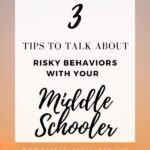3 Tips for Talking about Risky Behaviors with your Middle Schooler
This year, I have had the pleasure of being a Responsibility.org ambassador. I was compensated to write this post, but all opinions of course, are my own.
So recently, there was this tik tok challenge called ‘Devious Licks” that challenged students ( middle schools in particular) to steal from and vandalize school bathrooms and then post the videos online.
I vaguely remember hearing about it one morning a few weeks ago while running around doing errands but promptly forgot about it.
Until I got an email from Pookah’s school.

It seemed that the kids at his school had been doing this challenge for WEEKS and reached its peak when 6 students were caught in the act of stealing a toilet and were all suspended.
Full disclosure, Pookah has a tik tok account and an instagram account. ( Which I monitor within an inch of it’s life)
So to say I was concerned…was an understatement.
As soon as I picked him up at the bus stop, I pounced.
I was somewhat relieved that he thought the challenge was disgusting, but also worried that he knew what it was. And it started me worrying about if HE was being influenced and doing things like this without me knowing!
This incident provided me with the perfect opportunity to dive in and have an in-depth talk about risky behaviors and peer pressure.

Pookah is in middle school, and at the age where peer pressure is real, his hormones are singing to him and he is seeking new experiences.
It was a blessing, really, that I had just watched a Back to School Webinar with Repsonsibility.org about Preventing Underage Drinking and Risky Behavior with Tiffany Jones, M.Ed, Licensed Professional Counselor and Certified Substance Abuse Counselor ,Christine Koh, Music and brain scientist, parenting expert, and co-author of Minimalist Parenting and Jessica Lahey, New York Times bestselling author of the Gift of Failure and The Addiction Inoculation; Prevention Coach, Sana at Stowe.
Teens are wired to seek new experiences, and to seek rewards. According to Christine Koh, it is important to be mindful, aware and engaged about what we traditionally see as risky behavior( sex,drugs and alcohol).
A parents job is to create opportunities where our kids can stretch, extend and engage in healthy risk taking while setting boundaries and not hovering.
I needed to hear this because I’m the parent who either hovers or is totally hands off.
Nothing in between!
But I want to help Pookah navigate this new mindfield of peer pressure and risky behavior the safe way.
I used what I learned during this webinar to help to guide my conversation with Pookah and I think it will help me tackle future conversations as they come . So I wanted to share 3 tips for talking about risky behaviors with your middle schooler, tween, or teen.
3 Tips for Talking about Risky Behaviors with your Middle Schooler

When should we start talking to kids about risky behaviors?
The consensus of the panel was: AS SOON AS POSSIBLE, as in as early as the age of 9.
As Tiffany Jones stated: have the conversation early because if you aren’t having the conversation with your kids, more than likely they are already having this conversation with their peers.
As a person who tends to go into deep detail about things with my child( to his dismay) I appreciated the advice to only deliver the facts. Don’t exaggerate, don’t go to extremes. Just tell them exactly what they asked about and that is that.
And above all, walk into any conversation calmly( even if it’s a hard one) Because messages come through better when everyone is calm.
What are some ways to start these conversations?
According to Christine Koh, looking for everyday teachable moments makes it easier for your kid to relate and for you to get your point across without having to give a long detailed thought out speech. Kids, tweens and teens have short attention spans, and if we go on and on, we are going to lose them. Use things like social media, tv shows, songs to initiate short, frequent, ongoing conversations.
Dr Jones also suggested having these conversations in the car, because the kids can’t go anywhere or have daily check in conversations at dinner. Without our phones at the table. And when I thought about it, that is where a LOT of our convos happen in our home and it seems to be working.
How best to proceed if you find out that kids have already engaged in risky behaviors?
According to Jessica Lahey, be vigilant and don’t panic!
Look for change. If you see a rapid change in your child in sleep, diet or mood, it might be a sign that something is up. Even if it’s a good change, take note. Go to your child and talk about it so you can start a conversation and get a good understanding of what is going on.
And if you find that your child is engaging in risky behavior, don’t overlook resources and allies that you already have: like your child’s healthcare provider, school nurses, teachers, school counselors. These allies know what resources that are available in the community and can help you help your child.

Remember friends, according to Responsibility.org,research shows that we parents are still the most trusted source for our children. So don’t be afraid that your child isn’t listening. Don’t be afraid to have these conversations and worry they are going in one ear and out the other. They are listening and we can make a difference.
If you have further questions about how to talk to your child about risky behaviors, Responsibility.org is a great resource. Responsibility.org is a national not-for-profit organization and its mission is to eliminate drunk driving and underage drinking and to help adults to drink alcohol responsibly as a part of their lifestyle.
Questions?
